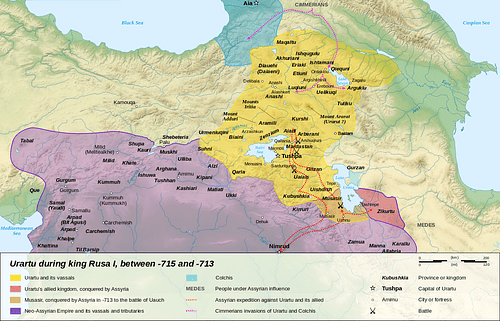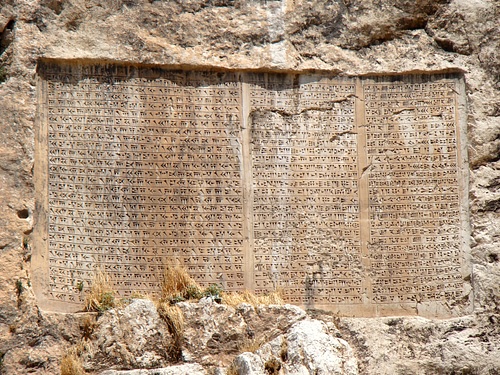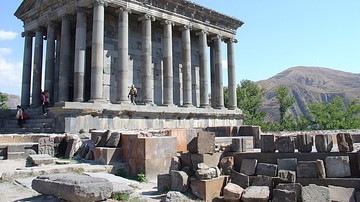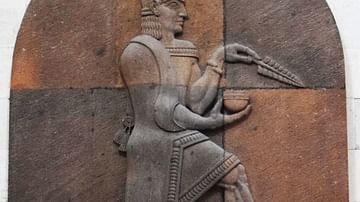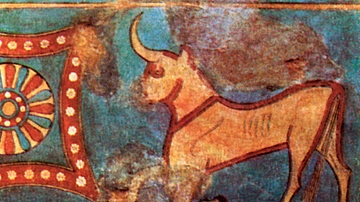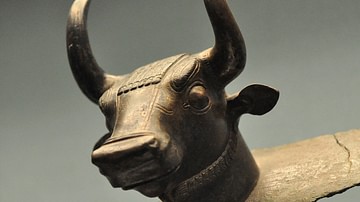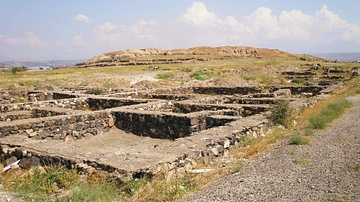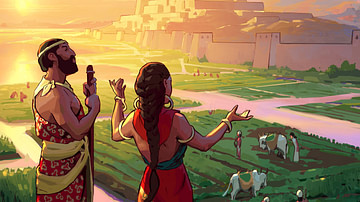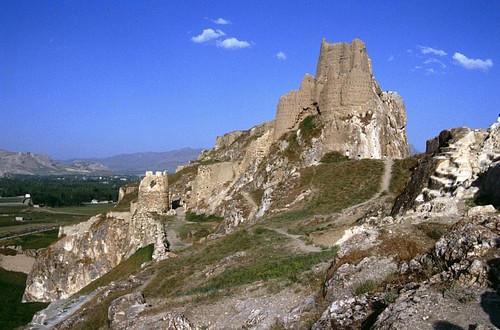
Tushpa, later known as Van, was the capital of the Urartu kingdom of ancient Armenia, eastern Turkey, and western Iran from the 9th to 6th century BCE. Located on the eastern shore of Lake Van in modern Turkey, the city was a fortress site which was reused as a provincial capital under the Achaemenian Empire and then, once again, made the capital of the Artsruni kingdom during the medieval period. Tushpa/Van is the oldest continuously inhabited city in the region.
Foundation
Tushpa was founded by king Sarduri I (r. c. 835 - 825 BCE) around 830 BCE to function as the capital of the Urartu civilization, a loose confederation of kingdoms which covered territories in Eurasia from the Euphrates River to Lake Urmia and territory north of the Taurus Mountains. In the highlands around Lake Van, the traditional heartlands of Urartu and subsequent Armenian kingdoms, the fortress of Tushpa was built on a limestone promontory on the eastern shores of the lake. The height of the rock is in places 115 metres (375 feet). The city was named after the goddess Tushpuea (aka Tushpues or Tushpua), who was the consort of Shivini, the Urartian sun god. The name Van derives from the Urartian people's name for their region, Biaina. Tushpa/Van perhaps had a population as high as 50,000 at its peak, and it subsequently gave its name to the region: Tosp.
A Garden City
Tushpa prospered thanks to the fertile plains around it, the Urartians' skills in animal husbandry, especially horse-breeding, and its location near trade routes which connected the Mediterranean with central Asia. The Urartians were also innovative and ambitious architects. Significant construction projects include the massive cyclopean walls of fortress Tushpa. With parts still standing today, the walls used huge stone blocks measuring around 6 m long and 75 cm thick. One portion of wall, perhaps originally intended as a pier or breakwater, carries an inscription in Assyrian. Carved during the reign of Sarduri I, it states:
An inscription of Sarduri, son of Lutipri, the magnificent king, the mighty king, king of the universe, king of the land of Nairi, a king having none equal to him, a shepherd to be wondered at, fearing no battle, a king who humbled those who would not submit to his authority. I, Sarduri, son of Lutipri, king of kings, received tribute from all the kings. Sarduri, son of Lutipri, says: “I procured this limestone from the city of Alniunu, I erected this wall”. (Piotrovsky, 49)
Another great engineering achievement was the 80-kilometre long stone-lined canal which brought fresh water from the Artos mountains to the capital (Lake Van is a saltwater lake). The structure was built by king Menua (r. c. 810-785 BCE) and allowed the proliferation of vineyards and orchards, resulting in Tushpa gaining a reputation as a garden city. The aqueduct was raised where necessary on large stone blocks and these often carry inscriptions which name the builder and warn of a curse on any person who destroys the structure or claims it as their own work as in this example:
Whosoever damages this inscription, whosoever overturns it, whosoever does such things according to his desire or in the name of another, Menua warns that the dread god Khaldi, the god Teisheba and the sun god Shivini will efface him from the sight of the sun. (Chahin, 74)
The canal continues to function and is still used today by farmers in the region to irrigate their fields.
During Menua's reign, the city also spread around the citadel and along the shores of Lake Van, which are fertile and sheltered from the harsher extremes of the region's climate. In the reign of Argishti II (r. c. 714-680 BCE), a new settlement was developed on the nearby hill of Toprakkale. The site, which became the royal palace, was completed by Argishti's son and successor Rusa II (c. 680-638 BCE) when it was renamed Rusahinili.
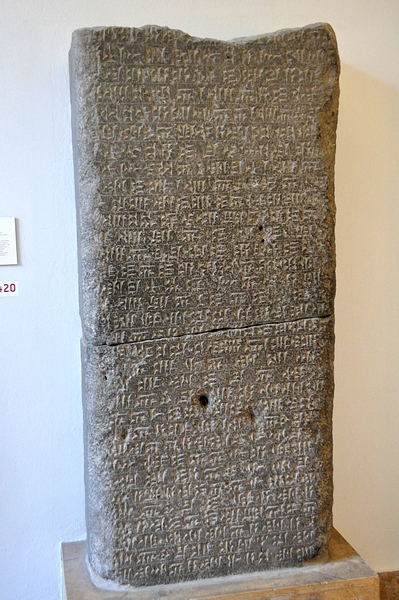
The capital had a royal necropolis composed of chambers cut into the mountain on which the city was built. Tombs are composed of single, double, or triple chambers with the tomb entrance sealed by a large stone slab. Several royal tombs, long since looted, still carry inscriptions describing the achievements of their occupant. Of those tombs discovered intact, several contain stone sarcophagi with semicircular lids. Buried with the deceased were precious goods, weapons, shields, and even furniture, a practice which suggests the Urartians believed in an afterlife and that it was similar enough to the earthly one to necessitate such provisions.
Other surviving remains from this period include an open-air shrine with smooth walls carved out of the rock, finds of figurines such as winged goddesses who might have once adorned bronze cauldrons, fragmentary stone statuary of deities, and many cuneiform inscriptions made into the rock face which describe the kings of Urartu and some of their great deeds.
Assyrian Wars
There were trade relations between Tushpa and the mighty Neo-Assyrian Empire but also major conflicts, too. Urartu did enjoy some victories in the mid-8th century BCE, but the Assyrian ruler Tiglath-Pileser III (r. 745-727 BCE) was more aggressive than his predecessors, and he laid siege to Tushpa in 736 BCE. The attack is recounted in the Assyrian annals of Tiglath-Pileser:
I shut up Sarduri [II] the Urartian in Turushpa [Tushpa], his principal city, and wrought great slaughter in front of the city gates. Then I set up the image of my majesty over against the city. (Piotrovsky, 83)
Fortunately for the Urartians, the city's walls did their job and the fortress remained impregnable. The Assyrians, nevertheless, torched and plundered the lower city, along with many others in the kingdom.
Another significant conflict between the two states was during the campaign of Sargon II (722-705 BCE) in 714 BCE, although Tushpa was not directly attacked. In the 7th century BCE, the Urartu kingdom came to a mysterious but violent end when sometime between c. 640 and c. 590 BCE their cities, including Tushpa, were destroyed. The state was probably weakened by decades of battles with the Assyrians, and it may have been too overstretched to control its own empire. The perpetrators are not known, but the Scythians are one candidate, the Cimmerians another, and even possibly forces from within the territories administered by the Urartu kings.
Achaemenid Rule
The territories the Urartu kingdom had once occupied were ultimately taken over by the Medes from c. 585 BCE onwards and Van was rebuilt. The region was shortly afterwards incorporated into the Achaemenian Empire of Cyrus the Great in the mid-6th century BCE. Van then became the seat of the Persian satrap who governed the new province. From this period comes the now-famous lengthy inscription on the rock face of Van. Made during the reign of Xerxes (486-465 BCE) it is written in the three official languages of the Achaemenian Empire - Old Persian, Elamite and Babylonian - and describes the king's divine right to rule over his empire:
A great god is Ormuzd, who is the greatest of gods, who created this earth, who has created that heaven, who has created mankind, who has given happiness to man, who has made Xerxes king, sole king of many kings, sole lord of many. I am Xerxes, the great king, the king of kings, the king of the provinces with many tongues, the king of this great earth far and near, son of king Darius the Achaemenian. Says Xerxes the King: Darius the king, my father, did many works, through the protection of Ormuzd, and on this hill he commanded me to make his tablet and an image; yet an inscription he did not make. Afterwards I ordered this inscription to be written. May Ormuzd, along with all the gods, protect me and my kingdom and my works. (Chahin, 69-70)
Hellenistic Period & Sasanid Rule
During the reign of the Orontid dynasty (6th-3rd century BCE), after the fall of the Persian Empire, Van was passed aside when Armavir (the former Urartian city of Argishtihinili) was made the capital c. 330 BCE. The city remained important and benefitted from the building projects of Tigranes the Great (r. c. 95 - c. 56 BCE) in the early part of the 1st century BCE, although he founded a new capital, Tigranocerta, in 83 BCE which was further to the west and in a more central position within the newly expanded Armenian Kingdom.
When the Arsacid dynasty ruled Armenia (12-428 CE) Artaxata was the capital but Van remained important in the region. The city's continued importance as a trading centre resulted in it acquiring a more cosmopolitan population; the Jewish community was especially large. When the Sasanid king Shapur II (r. 308-379 CE) invaded Armenia in 368-9 CE, Van was one of the cities attacked and its whole population was forcibly relocated to Persia.
Later History
Van did rise again to prominence during the medieval period when it was made the capital of the Artsruni (Ardsruni) kingdom which sprang up in Armenia from the late 8th century CE. The Artsruni prince Gagik, ruling under the auspices of the Abbasid Caliphate, made Van his capital in 908 CE. Yet again, the city was replaced as the royal residence, this time by Aghtamar, located on an island on Lake Van, but Van remained a thriving cultural centre if not a political one. Successively ruled by the Byzantines and Seljuk Turks, Van was sacked and destroyed in 1387 CE by Timur Leng, the Turco-Mongol conqueror (r. 1370-1405 CE) who then hurled 7,000 captives over the citadel's walls to their deaths. The city drifts into obscurity from then until the Ottoman period and a return to regional importance in the 19th century CE when it became a centre for Armenian rebellion against Turkish rule.
This article was made possible with generous support from the National Association for Armenian Studies and Research and the Knights of Vartan Fund for Armenian Studies.
